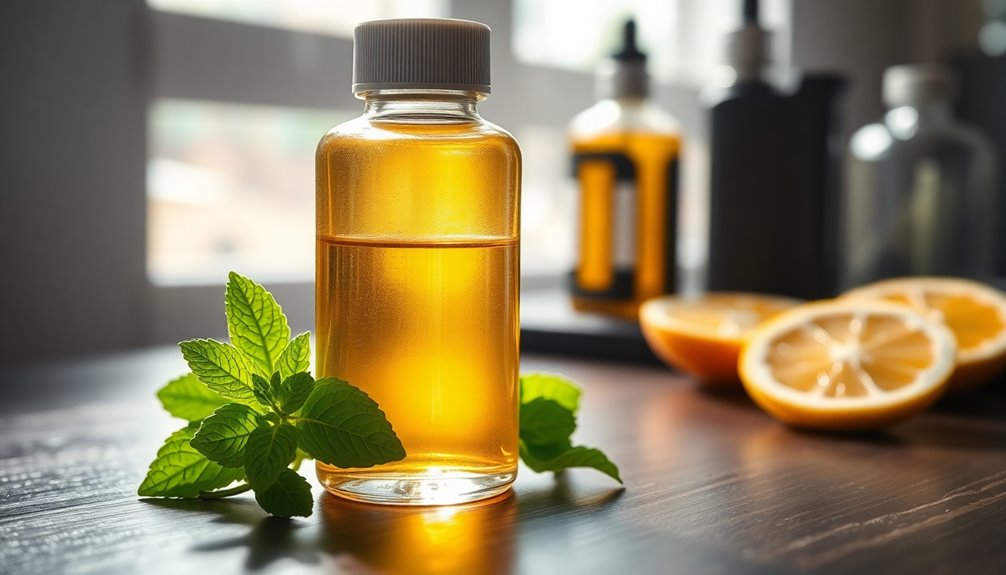To keep your vape juice fresh and prevent it from turning brown, store it in a cool, dark place, ideally between 60-80°F. Use dark glass containers to avoid UV exposure and ensure airtight seals to minimize air contact. Avoid temperature fluctuations, and check for expiration dates regularly. Remember, if you notice off smells or drastic color changes, it's time to replace your e-liquid. Stick around to discover more tips on maintaining freshness and quality.
Key Takeaways
- Store vape juice in a cool, dark place, ideally between 60-80°F (15-27°C), to slow down oxidation and discoloration.
- Use dark glass containers to protect e-liquids from harmful UV light that can degrade nicotine and flavorings.
- Seal bottles tightly to minimize air exposure, which accelerates oxidation and leads to browning.
- Regularly check for signs of spoilage, such as off smells or drastic color changes, and replace if necessary.
- Refrigerate or freeze e-liquids for long-term storage to maintain freshness and prevent discoloration.
Understanding Vape Juice Discoloration

When you notice your vape juice turning brown, it's often a sign of chemical changes that can affect your experience. Factors like light exposure and heat can speed up these changes, causing discoloration. UV rays break down nicotine and flavorings, while external heat sources from sunlight or your vaping device accelerate reactions. Proper storage in cool, dark places can help slow this process down. Additionally, minimizing air exposure during handling and storage is crucial, as it helps prevent oxidation. If your vape juice has high nicotine levels or complex flavor profiles, it's more susceptible to discoloration. Choosing high-quality ingredients and maintaining stable temperatures can also significantly reduce the risk of your vape juice turning brown. Proper storage in a cool, dark place is essential to extend the shelf life of your e-liquids.
The Role of Oxidation in Color Change

Vape juice discoloration is closely linked to oxidation, a natural chemical reaction that occurs when nicotine and other components come into contact with oxygen.
Nicotine, in particular, is highly reactive and breaks down quickly, causing a noticeable darkening of your vape juice. This process not only changes the color but can also affect the flavor, making it harsher over time. Higher nicotine levels accelerate the oxidation process, leading to quicker discoloration.
Environmental factors like light and heat can speed up oxidation, further contributing to discoloration.
When nicotine interacts with flavorings, propylene glycol, and vegetable glycerin, oxidation becomes more pronounced.
To keep your vape juice fresh, minimize exposure to air, light, and heat, which can all accelerate this chemical reaction and lead to unwanted changes in quality.
Impact of Storage Conditions on E-Liquids

Proper storage conditions can significantly affect the longevity and quality of your e-liquids. To maintain their flavor and consistency, keep your vape juice at a stable room temperature between 60-80°F (15-27°C). High heat can thin the liquid, change its color, and degrade flavors, while freezing temperatures can make the mix too thick. Avoid rapid temperature fluctuations, as they accelerate degradation. Additionally, correct storage helps slow oxidation and extends the shelf life of your vape juice. Light also plays a role; prolonged exposure can break down your e-liquids, so store them in dark places like cupboards. Finally, keep your e-liquids sealed tightly to minimize air exposure, which can lead to oxidation and flavor loss.
Choosing the Right Container Material

Maintaining the quality of your e-liquids goes beyond just storage conditions; the choice of container material plays a vital role as well. Glass containers are your best bet for preserving flavor, as they're non-reactive and durable. They also offer UV protection, especially in dark bottles, which helps prevent degradation from sunlight. Plus, glass is recyclable, making it an eco-friendly option. Additionally, keeping bottles sealed ensures that air exposure is minimized, further preserving the integrity of your e-liquids. On the other hand, while plastic containers are convenient and cost-effective, they may compromise flavor over time. They're safer since they won't shatter, but you'll need to consider their environmental impact. For long-term storage and flavor preservation, opt for glass. Your e-liquids will thank you for it!
E-Liquid Composition and Its Effects

While understanding e-liquid composition might seem daunting, it's crucial for anyone looking to preserve the quality of their vaping experience. E-liquids primarily consist of propylene glycol, glycerol, nicotine, and flavorants.
These ingredients can interact chemically, with flavorants like aldehydes reacting with PG and GL to form new compounds that alter the liquid's properties. Exposure to oxygen accelerates oxidation, causing e-liquids to darken, especially due to nicotine's reactivity. Additionally, high temperatures can caramelize sweeteners, further changing color. Be mindful that mixing flavorants might enhance toxicity beyond individual effects. Chemical interactions during vaping can also lead to unique toxicological effects that may impact your health.
Understanding these interactions helps you choose your e-liquids wisely, ensuring a fresher, safer vaping experience. Proper storage and ingredient awareness can significantly impact your enjoyment.
Maintenance Practices for Your Device

To keep your vape device performing at its best, regular maintenance is essential. Start with regular wipe-downs using a soft cloth to remove residue. Every few weeks, disassemble your device for a deep clean with warm water and isopropyl alcohol, avoiding harsh chemicals that could cause damage. Proper device upkeep ensures longevity and optimal performance. Don't forget to clean the mouthpiece for hygiene and airflow. Replace your coils and pods every one to two weeks to prevent burnt tastes. Inspect your device for leaks and clean connections to ensure smooth operation. Use only the recommended charger and avoid overcharging to protect the battery. Store your device in a cool, dry place, and always check for signs of wear or damage.
The Science Behind Steeping E-Liquids

Steeping e-liquids is a crucial process that enhances the flavor and aroma of your vape juice. During steeping, chemical reactions occur as ingredients bond, maturing the flavor profile. Allowing your e-liquids to absorb oxygen helps evaporate harsh volatile components, creating a smoother vaping experience. Factors like ingredient complexity and nicotine content can influence steeping times, especially for rich tobacco or dessert flavors. Additionally, the steeping process involves the removal of volatile components through evaporation and degasification, which can be accelerated by heat and increased surface area.
You can speed up this process with warmth, but be careful—excessive heat can degrade nicotine. Using glass bottles is ideal since they're non-reactive. Methods like the breathing technique or warm bath can facilitate steeping effectively. Remember, proper storage in cool, dark conditions is key for maintaining that enhanced flavor after steeping.
Safety Considerations for Discolored Vape Juice

Discolored vape juice can raise concerns, but it's important to assess its safety before deciding to use it.
Oxidation is a primary culprit behind discoloration, affecting nicotine and flavor compounds. While you might notice a harsher taste or slight decrease in nicotine potency, discolored juice is generally safe. Proper storage conditions, such as maintaining optimal freshness, can help slow down the oxidation process.
Take note, though, that off smells or drastic color changes may indicate spoilage. Persistent separation or sediment is another red flag. Always check expiration dates to ensure freshness.
Proper storage in cool, dark places can slow down oxidation, preserving quality.
Tips for Proper E-Liquid Storage

Proper storage is key to maintaining the quality of your e-liquids and preventing unwanted changes, like discoloration.
Use glass containers, especially dark glass bottles, to protect your e-liquids from UV light and chemical reactions. Ensure they've airtight seals to minimize air exposure and oxidation. Additionally, protecting vape juice from light and air is crucial to preserving both flavor and potency.
Store your e-liquids in a cool, dark place with a stable temperature around 25°C, avoiding direct sunlight and heat sources. For short-term storage, keep them in high cupboards and transfer leftovers to smaller containers to reduce air exposure.
If you're considering long-term storage, refrigerate or freeze your e-liquids, but remember to monitor expiration dates and rotate stock to keep everything fresh and flavorful.
When to Replace Your E-Liquids

Knowing when to replace your e-liquids is essential for maintaining a satisfying vaping experience. Keep an eye out for signs of degradation, like color changes. If your vape juice turns brown, it's likely oxidized and may taste harsh or bland.
Look for separation or cloudiness, as these indicate contamination. Reduced vapor production and unusual smells are also red flags. Typically, unopened bottles last 1-2 years, while opened ones should be used within 6-12 months. Always check the manufacturer's expiration date and perform regular visual inspections. Nicotine content can significantly impact the shelf life, so it's crucial to be aware of the level in your vape juice.
Trust your taste buds and nose to guide you. Prioritizing these signs will ensure you enjoy the best flavor and quality from your vape juice.
Frequently Asked Questions
Can I Still Vape Discolored E-Liquid?
Yes, you can still vape discolored e-liquid, as discoloration often results from nicotine oxidation and is generally safe.
Just check for any significant changes in taste, smell, or texture before using it. If it still tastes good and smells fine, you're likely good to go.
Additionally, make sure it's within its expiration date and stored properly to ensure the best experience.
Quality matters more than color when it comes to vaping.
What Are the Signs of Spoiled Vape Juice?
Did you know that up to 30% of vape juice can spoil before its expiration date?
You can spot spoiled vape juice by looking for significant color changes, cloudiness, or separation in the liquid. Additionally, a strong or off-putting smell can also indicate that the vape juice has gone bad. It’s essential to pay attention to these signs not only to ensure a pleasant vaping experience but also to maintain the quality of the product. By understanding how to identify spoiled vape juice, manufacturers can optimize juice production effectively, resulting in a better final product for consumers.
Pay attention to any unusual odors or harsh tastes, too.
If you notice a lack of nicotine effect or solid substances, it's time to discard it.
Properly assessing these signs keeps your vaping experience enjoyable and safe.
Does Steeping Always Cause Discoloration?
Steeping doesn't always cause discoloration, but it can lead to changes due to oxygen exposure.
When you steep your vape juice, you're enhancing the flavor but also allowing air to interact with the liquid, which may initiate oxidation.
To minimize color changes, consider using airtight containers and controlling the temperature.
How Long Can I Store Vape Juice Safely?
Think of your vape juice like a fine wine; it needs the right conditions to thrive.
You can safely store vape juice for 1 to 2 years if you keep it in a cool, dark place. Ensure it's in a glass bottle, tightly sealed after each use.
Avoid heat and light exposure to maintain its quality. Regularly check for any signs of degradation, so you can enjoy your vape at its best!
Can Flavorings Affect Discoloration Rates?
Yes, flavorings can definitely affect discoloration rates.
When you use complex flavors with multiple ingredients, they're more likely to interact and lead to browning.
Heat sensitivity also plays a role, as exposure to heat can darken your vape juice.
Additionally, certain flavorings are less stable and degrade faster, causing color changes.
Conclusion
Keeping your vape juice fresh is like tending a garden; with the right care, it flourishes. By understanding oxidation, choosing the right containers, and storing your liquids properly, you’ll maintain that vibrant flavor and color. Don’t let your e-liquids fade like an old photograph—embrace these tips to keep your vaping experience lively and enjoyable. Remember, when it comes to your vape, freshness is the secret ingredient to blissful clouds and satisfying hits! Additionally, be mindful of the fresh juice storage duration; ideally, use your vape juice within a few months of opening to ensure optimal flavor and quality. Opt for a cool, dark place to store your liquids, away from direct sunlight and heat, which can degrade their potency. By taking these simple precautions, you’ll not only enhance your vaping experience but also ensure every puff is as delicious as the last.
Cindy thoroughly researches juicing trends, techniques, and recipes to provide readers with practical advice and inspiration. Her writing style is accessible, engaging, and designed to make complex concepts easy to understand. Cindy’s dedication to promoting the advantages of juicing shines through her work, empowering readers to make positive changes in their lives through the simple act of juicing.

















